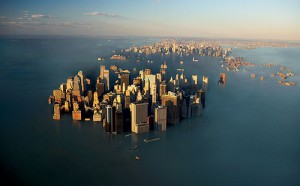American climate refugees could flee inland
By Tim Radford
LONDON, 27 April, 2017 – If humans go on burning ever greater volumes of fossil fuel, then dramatic rises in sea levels could turn 13 million US citizens into climate refugees and send them fleeing inland – many of them to Atlanta, Houston and Phoenix.
This latest study, in Nature Climate Change, builds on an earlier assessment of what could happen in 319 American coastal counties if sea levels rise 1.8 metres by 2100.
American refugees
The calculation at the time was that overall sea level rise could threaten the properties of 13.1 million people. This raised the question: where could they all go?
“We typically think about sea level rise as a coastal issue, but if people are forced to move because their houses become inundated, the migration could affect many landlocked communities as well,” says the study’s author, Mathew Hauer, a population scientist in the Department of Geography at the University of Georgia. He also led the original county-by-county estimates of the numbers at risk.
Worldwide, around 1 billion people live in low-lying coastal zones, and an estimated 180 million are at risk. The latest study is claimed as the first attempt to use mathematical simulations to calculate not just the attrition on the coasts, but the long-term consequences for landlocked communities, which will have to accommodate a new class of incomer: the climate refugee.
“The sheer magnitude of places affected
could alter the US population landscape”
In December 2015, more than 195 nations agreed in Paris to attempt to contain global warming to 1.5°C by drastically reducing fossil fuel emissions. But even if such promises are fulfilled, European cities could face sea level rises of more than 50cm by 2100, enough to put properties and lives at risk in cases of extreme storms and tidal surges.
Richer populations are assumed to be more likely to invest in coastal defences and some coastal communities will be less at risk than others, yet the cost of what Dr Hauer calls “adaptive infrastructure” in the US could reach $1 trillion.
But population change is inevitable. Miami, in Florida, could lose 2.5 million residents, and, altogether, nine states could see a population decline in response to a sea level rise of 1.8 metres. Texas, however, could gain 1.5 million citizens, demonstrating, says Dr Hauer, “that the sheer magnitude of places affected could alter the US population landscape”.
Amplified risk
The point of such research is to alert planners and civic authorities to what could happen. However, climate change and population growth will combine to amplify the risk from coastal windstorms and surges along the littoral, and cause very different problems inland.
“Some of the anticipated landlocked destinations, such as Las Vegas, Atlanta and Riverside, in California, already struggle with water management or growth management challenges,” Dr Hauer says.
“Incorporating accommodation strategies in strategic long-range planning could help alleviate the potential future intensification of these challenges.”
– Climate News Network




